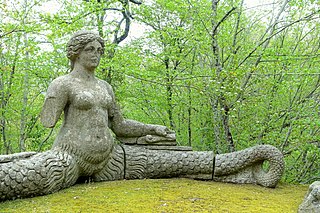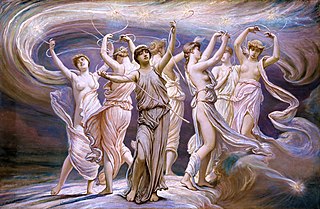Related Research Articles

In Greek mythology, Eris is the goddess and personification of strife and discord, particularly in war, and in the Iliad. According to Hesiod she was the daughter of primordial Nyx (Night), and the mother of a long list of undesirable personified abstractions, such as Ponos (Toil), Limos (Famine), Algae (Pains) and Ate (Delusion). Eris initiated a quarrel between Hera, Athena and Aphrodite, which led to the Judgement of Paris and ultimately the Trojan War. Eris's Roman equivalent is Discordia. According to Hesiod, there was another Eris, separate and distinct from Eris the daughter of Nyx, who was beneficial to men.

In Greek mythology, Styx, also called the River Styx, is a goddess and one of the rivers of the Greek Underworld. Her parents were the Titans Oceanus and Tethys, and she was the wife of the Titan Pallas and the mother of Zelus, Nike, Kratos, and Bia. She sided with Zeus in his war against the Titans, and because of this, to honor her, Zeus decreed that the solemn oaths of the gods be sworn by the water of Styx.

In Greek mythology, the Graeae, also called the Grey Sisters and the Phorcides, were three sisters who had gray hair from their birth and shared one eye and one tooth among them. They were the daughters of the primordial sea gods Phorcys and Ceto and, among others, sisters of the Gorgons and the Hesperides. Their names were Deino (Δεινώ), Enyo (Ἐνυώ), and Pemphredo (Πεμφρηδώ). The Graeae are best known from their encounter with Perseus, who, after capturing their eye, forced them to reveal information about the Gorgons.

In Greek mythology and religion, Themis is the goddess and personification of justice, divine order, law, and custom. She is one of the twelve Titan children of Gaia and Uranus, and the second wife of Zeus. She is associated with oracles and prophecies, including the Oracle of Delphi. Her symbol is the Scales of Justice.

In Greek mythology, Echidna was a monster, half-woman and half-snake, who lived alone in a cave. She was the mate of the fearsome monster Typhon and was the mother of many of the most famous monsters of Greek myth.
In Greek mythology, Erebus, or Erebos, is the personification of darkness. In Hesiod's Theogony, he is the offspring of Chaos, and the father of Aether and Hemera (Day) by Nyx (Night); in other Greek cosmogonies, he is the father of Aether, Eros, and Metis, or the first ruler of the gods. In genealogies given by Roman authors, he begets a large progeny of personifications upon Nox, while in an Orphic theogony, he is the offspring of Chronos (Time).

In Greek mythology, dreams were sometimes personified as Oneiros or Oneiroi. In the Iliad of Homer, Zeus sends an Oneiros to appear to Agamemnon in a dream, while in Hesiod's Theogony, the Oneiroi are the sons of Nyx (Night), and brothers of Hypnos (Sleep).
In Greek mythology, Hippothoe is the name of five distinct characters.
In Greek mythology, Thaumas or Thaumant was a sea god, son of Pontus and Gaia, and the full brother of Nereus, Phorcys, Ceto and Eurybia.

In Greek mythology, Electra was one of the Pleiades, the seven daughters of Atlas and Pleione. She lived on the island of Samothrace. She had two sons, Dardanus and Iasion, by Zeus.
In Greek mythology, the Machai or Machae are collectively the personification of battle and war. In Hesiod's Theogony, the Machai are listed among the children of Eris (Strife). Like all of the children of Eris given by Hesiod, the Machai are a personified abstraction, allegorizing the meaning of their name, and representing one of the many harmful things which might be thought to result from discord and strife, with no other identity.
In Greek mythology, Oizys, or Oezys, is the personification of pain or distress. In Hesiod's Theogony, Oizys is one of the offspring of Nyx (Night), produced without the assistance of a father. Oizys has no distinct mythology of her own.

Ceto is a primordial sea goddess in Greek mythology, the daughter of Pontus and his mother, Gaia. As a mythological figure, she is considered to be one of the most ancient deities, and bore a host of monstrous children fathered by Phorcys, another child of Gaia and Pontus. The small Solar System body 65489 Ceto was named after her, and its satellite after Phorcys.
In Greek mythology, the Phonoi are collectively the personification of murder. In Hesiod's Theogony, the Phonoi are listed among the children of Eris (Strife). The Phonoi are named in line 228 of the Theogony, which lists four personified plural abstractions, the Hysminai (Combats), the Machai (Battles), the Phonoi (Murders), and the Androktasiai (Slaughters), as being among the offspring of Eris (Strife):
In Greek mythology, the Androktasiai are collectively the personification of the slaughter of men in battle. The Androktasiai are named in line 228 of Hesiod's Theogony, which lists four personified plural abstractions, the Hysminai (Battles), the Machai (Wars), the Phonoi (Murders), and the Androktasiai, as being among the several offspring of Eris (Strife):
Ὑσμίνας τε Μάχας τε Φόνους τ’ Ἀνδροκτασίας τε
In Greek mythology, Phalerus or Phalereus (Φαληρεὺς) may refer to the following characters:
In Greek mythology, Electra was one of the 3,000 Oceanids, water-nymph daughters of the Titans Oceanus and his sister-spouse Tethys.
In Greek mythology, Cymothoë was the "cerulean" Nereid of gentle and quiet waves. She was a marine-nymph daughter of the "Old Man of the Sea" Nereus and the Oceanid Doris.

In Greek mythology, Lethe is the personification of forgetfulness and oblivion. According to Hesiod's Theogony, Lethe was the daughter of Eris (Strife), with no father mentioned. Her name was also given to Lethe, the river of oblivion in the Underworld.
References
- Caldwell, Richard, Hesiod's Theogony, Focus Publishing/R. Pullins Company (June 1, 1987). ISBN 978-0-941051-00-2. Internet Archive.
- Gantz, Timothy, Early Greek Myth: A Guide to Literary and Artistic Sources, Johns Hopkins University Press, 1996, Two volumes: ISBN 978-0-8018-5360-9 (Vol. 1), ISBN 978-0-8018-5362-3 (Vol. 2).
- Hard, Robin, The Routledge Handbook of Greek Mythology: Based on H.J. Rose's "Handbook of Greek Mythology", Psychology Press, 2004, ISBN 9780415186360. Google Books.
- Homer, Iliad, Volume I: Books 1-12, translated by A. T. Murray, revised by William F. Wyatt, Loeb Classical Library No. 170, Cambridge, Massachusetts, Harvard University Press, 1999. Online version at Harvard University Press. ISBN 978-0-674-99579-6.
- Homer, Iliad, Volume II: Books 13-24, translated by A. T. Murray, revised by William F. Wyatt, Loeb Classical Library No. 171, Cambridge, Massachusetts, Harvard University Press, 1999. Online version at Harvard University Press. ISBN 978-0-674-99580-2.
- Homer, Odyssey, Volume I: Books 1-12, translated by A. T. Murray, revised by George E. Dimock, Loeb Classical Library No. 104, Cambridge, Massachusetts, Harvard University Press, 1998 (first published 1919). ISBN 978-0-674-99561-1. Online version at Harvard University Press.
- Homeric Hymn 5 To Aphrodite, in Homeric Hymns. Homeric Apocrypha. Lives of Homer, edited and translated by Martin L. West, Loeb Classical Library No. 496, Cambridge, Massachusetts, Harvard University Press, 2003. ISBN 978-0-674-99606-9. Online version at Harvard University Press.
- Hyginus, Gaius Julius, Fabulae in Apollodorus' Library and Hyginus' Fabulae: Two Handbooks of Greek Mythology, Translated, with Introductions by R. Scott Smith and Stephen M. Trzaskoma, Hackett Publishing Company, 2007. ISBN 978-0-87220-821-6.
- Hyginus, Gaius Julius, Fabulae . Latin text at packhum.org.
- Liddell, Henry George, Robert Scott, A Greek-English Lexicon , revised and augmented throughout by Sir Henry Stuart Jones with the assistance of Roderick McKenzie, Clarendon Press Oxford, 1940. Online version at the Perseus Digital Library.
- Most, G.W. (2018a), Hesiod, Theogony, Works and Days, Testimonia, Edited and translated by Glenn W. Most, Loeb Classical Library No. 57, Cambridge, Massachusetts, Harvard University Press, 2018. ISBN 978-0-674-99720-2. Online version at Harvard University Press.
- Most, G.W. (2018b), Hesiod: The Shield, Catalogue of Women, Other Fragments, Loeb Classical Library, No. 503, Cambridge, Massachusetts, Harvard University Press, 2007, 2018. ISBN 978-0-674-99721-9. Online version at Harvard University Press.
- Quintus Smyrnaeus, Posthomerica , edited and translated by Neil Hopkinson, Loeb Classical Library No. 19, Cambridge, Massachusetts, Harvard University Press, 2018. ISBN 978-0-674-99716-5. Online version at Harvard University Press.
- West, M. L. (1966), Hesiod: Theogony, Oxford University Press. ISBN 0-19-814169-6.